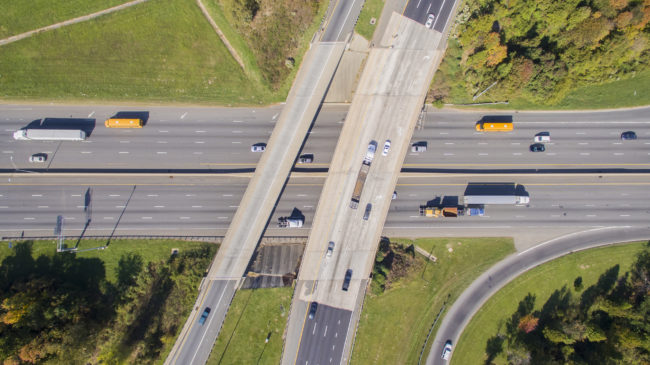The Fixing America’s Surface Transportation Act (FAST), signed into law in 2015, guides federal surface transportation policy and funding. It is set to expire on Sept. 30. In the last 18 months, Congress has made a few attempts to pass a reauthorization of the surface transportation bill, but those efforts have failed to gain traction, largely because of a lack of revenue for the spending legislators are looking for.
The federal bills proposed to replace the FAST Act included major funding increases. The House bill, the Investing in a New Vision for the Environment and Surface Transportation (INVEST) Act, would have increased surface transportation spending by 50 percent. The Senate bill, America’s Transportation Infrastructure Act (ATIA), would’ve raised spending by 20 percent. Yet neither proposal identified where this additional money would come from.
Now, Congress is left trying to kick the can down the road, get past the election, and pass a one-year extension of the FAST Act.
In the past, Congress has funded transportation reauthorizations with gimmicks such as pension smoothing and double-counting Federal Reserve revenue. Because gas tax collections no longer provide enough revenue to cover the high transportation spending levels legislators prefer, Congress has transferred an increasing amount of general fund revenue into the Highway Trust Fund to keep the spending going.
In addition to subjecting long-term transportation funding to the short-term whims of Congress, this also dilutes the users-pay/users-benefit funding principle that has been the bedrock of federal transportation policy since 1956.
While the INVEST and ATIA bill authors and supporters were failing to find new revenue sources to pay for their chosen priorities, the bills were also set to constrain one of the most promising sources of surface transportation funding: tolling.
The House’s INVEST Act would have repealed the Interstate System Reconstruction and Rehabilitation Pilot Program (ISRRPP) that allowed states to rebuild one of their Interstate corridors using toll financing. It was first authorized more than 20 years ago, but no states have made use of the program. But now, several states, including Indiana, Michigan, and Wisconsin are interested in using tolling to reconstruct aging, deteriorating highways. Eliminating the program would make paying for these needed projects more challenging.
The INVEST Act would have also eliminated the Value Pricing Pilot Program (VPPP), which has spurred innovative pricing projects from managed lanes to parking pricing to pay-as-you-drive insurance. Oregon plans to use its VPPP slot to rebuild Portland-area Interstates with tolling. Yet the House Transportation and Infrastructure Committee Chairman Peter DeFazio, who represents Oregon, pushed for the elimination of the program. Perhaps Rep. DeFazio does not agree with tolling or the Oregon Department of Transportation’s approach, but local disagreements should not damage federal transportation policy and prevent needed tolling projects in the rest of the country.
The most troubling provision in the INVEST Act was the requirement for every toll project to have a separate, federally-approved tolling agreement. This inserts the federal government into state and local transportation projects, runs counter to previous attempts to mainstream tolling, and, given that the law would have made the projects ensure that air quality, mass transit, environmental justice, and equity were taken into account, one has to wonder if it is designed to provide a way for opponents of infrastructure projects to derail needed improvements across the country.
The Senate’s ATIA was a somewhat better proposal but also had its own limitations as it mostly sought to maintain the failing status quo, which brought us to this funding standstill. In terms of tolling, ATIA would have expanded the Interstate highway tolling program to urban areas but would not have removed the restrictions on tolling Interstate highways that deter many states from considering all options.
Given that states own their portions of the Interstate system, Congress should not micromanage how states fund roadways. If states have some form of users-pay/users-benefit funding source that does not inhibit interstate commerce, Congress should not stand in the way. It’s no wonder that some states would like to stop sending state gas tax money to Washington and replace the federal gas tax with an equivalent state gas tax that stayed in those locations.
Right now, a more realistic solution would be for states seeking reliable revenue streams for highway projects to work with Congress to expand tolling.
Some legislators have concerns about tolling and worry about the diversion of toll revenue to the state’s general fund or other non-highway purposes. Many states divert gas taxes to fund non-transportation purposes, and some already divert toll revenue, including New Jersey, New York, Pennsylvania, and Virginia. Others worry that certain user groups will have to pay high tolls while others get a free ride. For example, Rhode Island imposes bridge tolls on trucks but not cars.
These concerns are legitimate. Yet state and federal leaders do not have to choose between problematic tolling and no tolling. Congress can solve this problem by adopting six customer-friendly tolling principles for new tolling:
- Make new tolls all-electronic and collected per mile;
- Use tolls to replace, not supplement, state fuel taxes;
- Prohibit toll revenue diversion;
- Start charging new tolls on a roadway only after it has been reconstructed;
- Collect tolls on all vehicles; and,
- Charge the same toll rate to all users of a given vehicle class.
Adopting these fair provisions would give highway users the peace of mind that tolls go to maintain and upgrade the roads they’re changed on, provide value for drivers’ money, be fair and easy to collect, and would not be used as cash cows for non-roadway purposes.
By easing tolling restrictions Congress could allow states to be the laboratories of democracy, unlock a new, reliable funding source that enables them to pay for needed infrastructure and have sufficient revenue to fund responsible stewardship of their roadways.
As Congress continually fails to identify sources for long-term transportation funding, tolling should be viewed as a critically important tool that can be used to help rebuild the aging Interstate Highway System. The next federal surface transportation reauthorization bill should not restrict tolling. Rather, Congress should unlock an important funding option that can be implemented with some common-sense guardrails to protect taxpayers.

